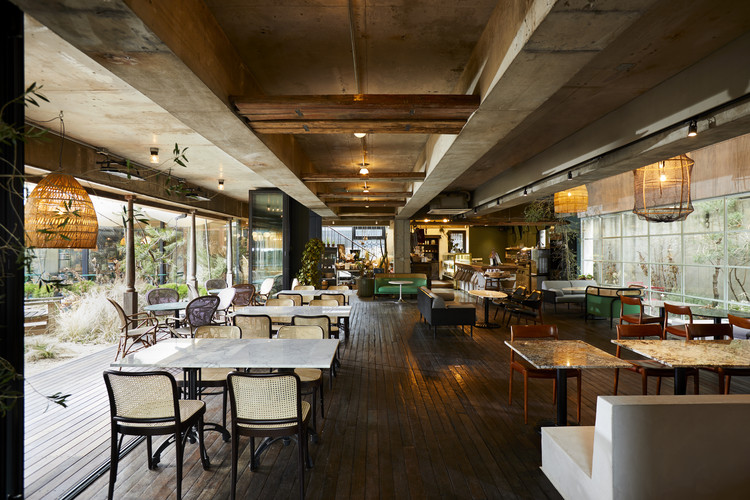V’ House Wiel Arets Architects
2013-12-16 01:00
© Jan Bitter
(扬·斯泰特)


架构师提供的文本描述。V‘House是为一对收集古董汽车的夫妇建造的,是在中世纪马斯特里赫特挂毯内缝制的。这座城市规定,所有新建筑都保留在现有建筑的围护范围内,因此在房子的前立面上划出一个切口,形成一个三角形的表面,从一个邻居的倾斜屋顶延伸到另一个邻居的垂直承重墙。由于房屋的场地又长又窄,因此将空隙切割成允许的最大体积,以确保自然光线在室内溢出。一楼是开放的外部元素和下沉到后方的网站,这使得最大的两层高度允许可能。这一外部空间的一个覆盖部分用作业主收集阿斯顿马丁斯的室外停车场。
Text description provided by the architects. V’ House was constructed for a couple that collects vintage cars, and is stitched within the medieval tapestry of Maastricht. The city dictates all new structures remain within the envelope of pre-existing buildings, and so a cut was created in the house’s front façade to generate a triangulated surface, which leads from one neighbor’s sloped roof to the opposite neighbor’s vertical bearing wall. As the house’s site is long and narrow, voids were cut into the maximum permitted volume to ensure that natural light spills throughout the interior. The ground floor is both open to the exterior elements and sunken to the rear of the site, which makes possible the maximum two-story height allowance. A covered portion of this exterior space serves as an outdoor parking garage for the owners’ collection of Aston Martins.
© Jan Bitter
(扬·斯泰特)


当房子在两座历史建筑之间找到避难所时,它在马斯特里赫特这个正在变得绅士化的社区里爆发出一股现代性。房子是巨大的,总共530平方米,是通过两个超大的滑动玻璃门,穿它的正面。这些门是房屋的主要入口,向左或右开放,步行进入,并同时收回以允许汽车进入。
As the house finds refuge between two historical buildings, it is a burst of modernity within this currently gentrifying neighborhood of Maastricht. The house is enormous, totaling 530 m2, and is entered through two oversized sliding glass doors that perforate its front façade. These doors serve as the house’s main entry and open to either their left or right for entry by foot, and both simultaneously retract to allow the entry of automobiles.
© Jan Bitter
(扬·斯泰特)


出于安全和隐私的考虑,这些玻璃入口门没有手柄或钥匙孔,而是从任何iPhone或世界上任何地方远程打开。为了更好地保护隐私,房子的前立面被一种渐变的圆点图案烧成了一团,当房子向天空升起,聚焦在远处,形成一幅窗帘在风中飘动的图像时,这些圆点就散开了。实际窗帘对前外观的内部,以提供更多的隐私。
Due to safety and privacy concerns, these glass entry doors have no handles or keyholes and are instead are remotely opened from any iPhone, from anywhere in the world. For further privacy the house’s front façade was fritted with a gradient pattern of dots, which disperse in placement as the house rises towards the sky and focus at a distance to compose an image of curtains fluttering in the wind. Actual curtains align the interior of the front façade to afford additional privacy.
© Jan Bitter
(扬·斯泰特)


整个房子的循环通过两条路径进行。一个“慢”楼梯从底层通向宽敞的客厅,通过一个小坡道连接到部分隆起的厨房和餐厅。一个“快速”的楼梯井穿越整个房子的高度,并与平台电梯,允许直接垂直快捷键到所有阶层的生活。因此,这座房子的多重循环干预措施,比如起居室坡道和“快”和“慢”道,并不是围绕着传统的层叠地板的概念组织起来的,而是围绕着它的循环部分组织起来的。在这条“快速”路线的顶端,是一个宽敞的屋顶露台的入口,这也是房子中最公共的空间,因为它提供了马斯特里赫特尖顶屋顶的全景景观。
Circulation throughout the house occurs via two paths. A 'slow' stair leads from the ground floor to the expansive living room, which is connected to the partially raised kitchen and dining areas by a small ramp. A 'fast' stairwell traverses the entire height of the house and, together with the platform elevator, allows for direct vertical shortcuts to all levels of living. Thus this house, with its multiple circulation interventions, such as its living room ramp and ‘fast’ and ‘slow’ paths, is organized not around the traditional notion of stacked floors and is instead organized around its circulatory section. At the apex of this 'fast' route is the entrance to an expansive roof terrace that’s also the most public space of the house, as it offers panoramic views over the spired roofline of Maastricht.
© Jan Bitter
(扬·斯泰特)


起居室已经悬挂在两个I梁,横跨两个砖石承重墙,围绕着现场的后方。钢拉杆的长度为5x10厘米,从这些I梁延伸到几乎全玻璃的客厅外墙,这使得它的体积漂浮在下面的阿斯顿马丁。出于隐私的原因,这种玻璃被处理的高反光涂层,铸造颜色的夏绿色或琥珀色取决于季节和角度的太阳。只有在主卧室居住时,起居室的这种悬挂才是明显的,因为从主卧室可以看到I-光束,它打开了起居室的屋顶,作为业主的私人露台。
The living room has been suspended from two I-beams that span two masonry bearing walls that surround the rear of the site. Steel tension rods measuring 5x10 cm extend from these I-beams into the almost fully glazed façade of the living room, which allows its volume to float above the Aston Martins below. For privacy reasons, this glazing was treated with a highly reflective coating that casts a hue of chartreuse or amber depending on the season and angle of the sun. Only when inhabiting the master bedroom is this hanging of the living room apparent, as the I-beams are visible from the master bedroom, which opens onto the living room's roof, which functions as a private terrace for the owners.
© Jan Bitter
(扬·斯泰特)


暖气和冷却是通过隐藏在房屋地板和天花板内的混凝土核心激活系统提供的,而所有的储藏室都建在循环系统中,以便划分空间和确定房间。这些定制的存储单元还为办公室空间配备了设备,它们隐藏了一张可以放低的床,以容纳临时访客,比如业主现在长大的孩子。
Heating and cooling is provided via a concrete core activation system concealed within the floors and ceilings of the house, while all storage is built into the circulatory areas in order to divide spaces and define rooms. These custom designed storage units also outfit the office space, where they conceal a bed that can be lowered to accommodate temporary visitors, such as the owners' now grown children.
Section A - A
A-A节


所有的存储区域都会因为流体的整合而退却,这使得房子的内部保持弹性,并为短暂的定义开放。一件定制的厨房是用不锈钢建造的,与之相连的餐桌向前立面伸出3.5米的悬臂。定制的陈设和储藏空间,加上现场混凝土和多屋顶露台,使V‘房子成为一个自由空间在一个规范的遗产环境中的表达。
All storage areas recede in prominence due to their fluid integration, which allows the house's interior to remain flexible and open for ephemeral definition. The one-piece custom designed kitchen was constructed in stainless steel, and the dining table, which is connected to it, cantilevers 3.5 m toward the front façade. The custom furnishings and storage spaces, together with the in-situ concrete and multiple roof terraces, make the V’ house an expression of free space in a regulated heritage context.
















































Architects Wiel Arets Architects
Location Maastricht, The Netherlands
Category Houses
Architect in Charge Wiel Arets Architects
Area 530.0 sqm
Project Year 2013
Photographs Jan Bitter
























